What is the success rate of laser hair removal?
Laser hair removal has a very high success rate. The majority of people will achieve long-lasting results after a full course of treatment. For most people, 6 sessions of laser is not enough. More sessions are needed to achieve a long-term reduction in hair growth. The success rate of treatment is largely dependent on following the guidelines set out for treatment. However, the most important factor is the colour and density of the hair in the treatment area.
Laser will work best on hair that contains dark pigment/colour, hairs that are red, blond, grey, or white will not respond to treatment. Hairs that are thick and coarse will also have a much higher success rate, laser may struggle to successfully treat hairs that are thin and light in texture.
How many sessions of laser are needed to achieve successful results
Generally 6-10+ laser hair removal treatments are needed for most areas for laser to be successful. However, some areas may need more. Laser works best on hairs that are dark in colour and coarse in texture. Areas like the underarm, bikini and lower legs have a very high success rate. These areas of excess body hair would significantly reduce after a course of 6-10 treatments. In areas where hairs are lighter in texture and colour more sessions may be needed. These areas would include, the upper thighs, arms, abdomen, facial hair, and neck. It is not uncommon for people to need up to 12+ treatments in these areas. The reason for this is lighter hairs absorb much less heat from the laser. Unwanted hairs that are dark in colour and thick in density rapidly absorb heat during treatment.
Other issues like underlying health or hormonal issues can also affect how many sessions you will need. Hereditary hair growth may also be a factor, if someone is predisposed to genetically having more hair it may take longer to remove this. Men would also typically need more sessions due to their hormone profile. Because hair growth is caused by a number of factors it is impossible to put an exact figure on how many sessions each individual person will need. As a course of treatment is progressing it is important to monitor your results so you can update your laser specialist. By doing this, changes can be made to your treatment plan early on to help improve your results.
Why 6 sessions of laser hair removal is not enough
6 sessions of laser hair removal will not be enough to achieve a successful, long lasting result in relation to unwanted hair growth. In the past laser hair removal was a treatment that was recommended in a bundle of 6 sessions. This gave consumers the idea that they would only have to purchase 1 course and after 6 sessions their hair would miraculously disappear. This unfortunately is not the case.
For laser to be successful hairs need to be in a specific growth phase and will need a certain level of heat in order to reduce them. After 6 sessions of laser growth will be greatly reduced, however some level of regrowth will remain. Treatment settings at this point will be on the higher end of the scale so any growth that remains will be targeted with much higher intensities of energy during treatment. Undoubtedly these high settings will ensure that any hairs that are left from session 7+ on will be treated much more effectively leading to a longer lasting reduction in growth.
Why more laser sessions may be needed to improve your success rate?
We have 1000’s of hair follicles all over our bodies. Each hair follicle is in a different phase of growth and some are dormant too. There are 3 stages of growth that hairs are in at any one given time anagen , catagen and telogen. For laser to be successful, hairs in the treatment area on the day of treatment must be in an anagen or active growth phase. In this phase hairs are attached to a blood supply. The blood supply is feeding the hair nutrients helping it to grow. When we perform laser we deliver tiny pulses of energy into the skin. These pulses of energy deliver heat into the skin and target the interconnecting cells between the hair root and blood supply. If enough heat is delivered this destroys these interconnecting cells so another hair cannot grow.
This is a very safe procedure and does not harm the skin or tissue in any way. Hairs in the other 2 stages of growth, catagen and telogen are not attached to the blood supply so laser will have no effect on these follicles during treatment. Follicles transition between these phases all of the time so that is why we need to perform a number of treatments in order to catch hairs in the correct cycle of growth.
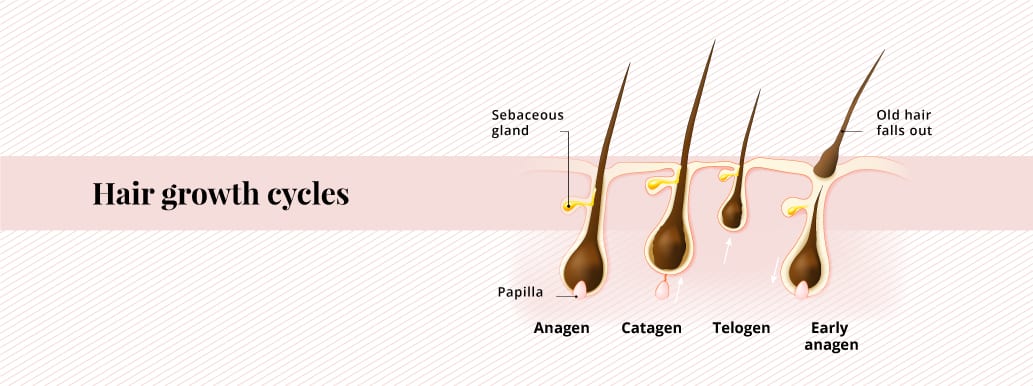
How do we know how many hairs we are treating per session?
An average of approximately 20% of hairs on the body are in this anagen stage on a daily basis. This is an approximate figure and there is no way to check how many of your hair follicles are active. Hairs on the scalp have a much longer growing phase so that is why they can grow longer. Hairs on the body have a growth phase of approx 45 days. This is why we wait 6-8 weeks in between each session. The other 80% of hairs are either in the other 2 stages of growth. In catagen hairs are transitioning and are getting ready for the telogen stage where they shed. Laser will have no effect on these two stages.
Because we have no way of knowing the exact amount of follicles in this growing phase laser can take some time. As a rule, hairs should become lighter, finer and much easier to shave after each laser session. Shaving should only needed 1-2 in between each session also.
How laser hair removal works?
Laser works by delivering heat into the hair follicle. During treatment pulses of energy from the laser are delivered into the skin. Different skin types require a specific delivery of this heat into the skin for safety reasons. To treat pale/medium skin types an Alexandrite laser is used. An Nd:Yag is used to treat darker skin tones. The energy delivered by the Alexandrite is absorbed by the dark pigment contained within the hairs themselves. The Nd:Yag works slightly differently, this wavelength absorbs into the blood supply that nourishes the hair.
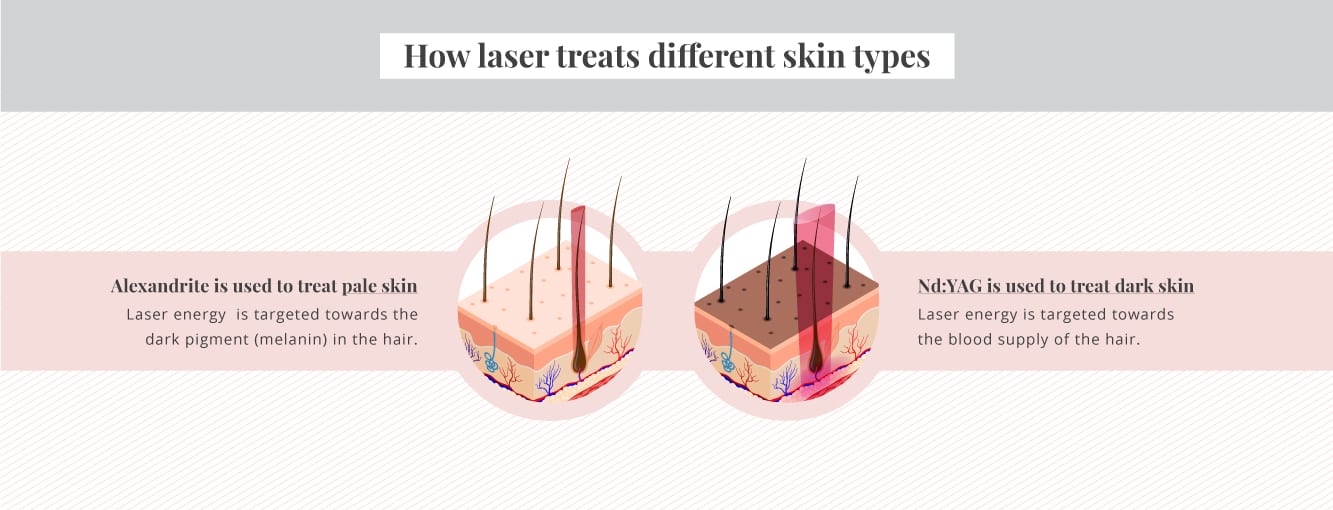
An Alexandrite laser should never be used on dark skin, this wavelength absorbs too rapidly into melanin and may cause a skin reaction.
Factors that contribute to the success rate of laser
Before embarking on a course of treatment please keep the following in mind. In order to maximize the success rate of your laser treatment try to focus on these points.
Regular treatments
Try to be consistent with your time frames in-between your sessions. Gaps of between 4-6 weeks for face and 6-8 for body areas recommended initially. Leaving longer periods in between sessions may impact on your results. Try to keep these timeframes for at least 6 sessions, after this time you can start to extend out a little until you eventually will only need top ups every 6 months.
Experienced therapists
Without a doubt you will get a better success rate from your treatments if you choose to have them with a dedicated hair removal clinic. Because they are solely performing hair removal treatments they are focused on just one treatment and are not distracted by others. In order to achieve the best results have your sessions with the same therapist if possible. The benefits to this are endless, they know your skin type, settings, sensitivity and will be able to gain a much higher success rate for your treatments. If you have a different therapists for each one of your treatments your results may be slower.
Type of laser used
Not all lasers are equal, success rates vary greatly depending on what machine you choose. Look for lasers that have been clinically trialed and tested to work and give long lasting results. Even though some machines are advertised as lasers they may not be so be careful to do your research. After many years experience we would always recommend Alexandrite lasers for pale skin types and Nd:Yag for darker skin types. Not all lasers are suitable for darker skin tones so be sure to find a laser that is safe to use if you have darker skin.
Preparing the skin properly before each session
Undoubtedly this is one of the most important aspects in terms of the success rate of your treatments. How you prepare for each one of your treatments matters, a lot. If you prepare your skin properly your settings can be increased safely, your treatment will be much more effective and long term results will benefit. If you don’t follow the recommended guidelines the intensity of treatment may have be lower, your treatment outcome may not be as good and you may need more sessions to achieve your desired results. It’s really easy to prepare for treatment, focus on this and get the best out of each one of your hair removal treatments.
Hair removal methods in between treatments
Unlike other methods of hair removal you can remove your hair in between your sessions. This must be done by shaving or using hair removal cream only. In order for laser to be effective hairs must remain in the follicle. Waxing, plucking, epilating and threading must be completely avoided. Unlike shaving and HR cream these forms of hair removal completely remove hairs leaving an empty hair follicle. If you do this the laser will have nothing to target during treatment. Shaving must be carried out 24 hours before your session is due. If you choose to use hair removal cream you must use this 48hrs before your session.
Keeping your skin tone stable
Last but not least, this point can have a huge impact on the success rate of your course of laser. It is best to commence a course of treatment when your skin tone is at it’s very palest for pale to mid toned skin types. The laser used to treat these skin types has one main focus, absorbing into melanin. When the laser pulses over the skin it seeks out anything that contains this pigment and heat is absorbed from the laser. This is why it works so well on these skin types.
Pale to mid skin tones have less melanin present in the skin so the laser will bypass the skin and the laser will focus on the dark hairs. When you allow your skin to tan by exposing it to sunlight your melanocyte cells will naturally produce more of this pigment in the skin. If we laser when these are active in the skin the laser has the potential to target the skin in an adverse way resulting in pigmentation. If you allow your skin tone to change during your course your settings may need to be reduced which may slow down your results and lead to you needing more sessions.
Keeping your skin tone as pale as possible so the laser focuses on your hair and not on your skin is of utmost importance.
When treating naturally darker skin tones we use a different wave length of laser which doesn’t target the melanin in your skin. Nd:Yag is suitable for darker skin tones and is very effective at targeting and removing hairs. It may take slightly longer to see results but as this laser is not targeting pigment it is very safe to use on darker skin types.
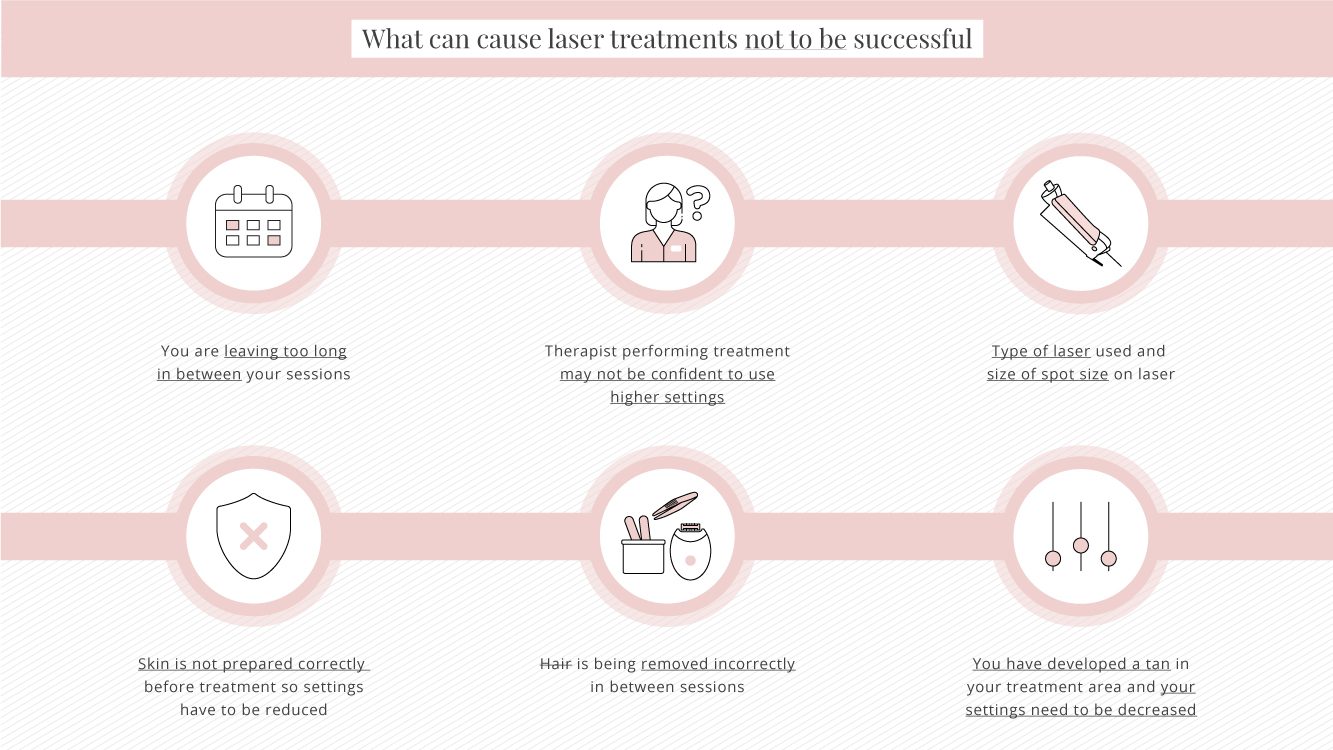
Our top tips for success – Get the best out of each one of your sessions
Preparation for each session is key to a successful treatment. By missing just one step it may impact on the outcome of a treatment. Be consistent and follow the same routine before each session. Set aside some time the day before your session to make sure you have followed each step correctly.
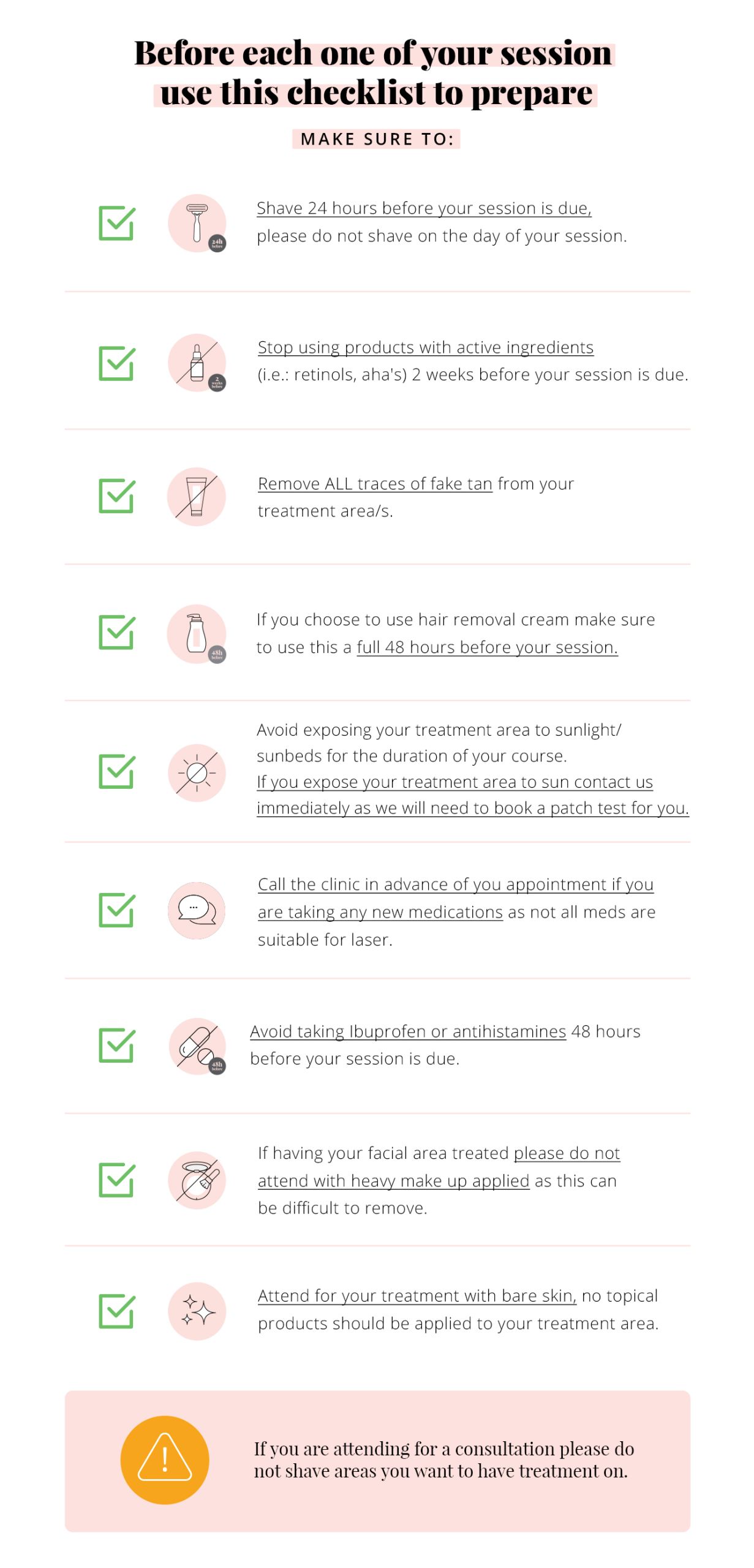
Laser is the most successful way to permanently reduce your hair
Lets face it, there’s a lot more you could do with your time other than removing hair. The constant daily or weekly effort of having to do this can be exhausting. You spend money on waxing, razors, shaving foam and hair removal cream on a monthly basis for results that last days or weeks at best. There is a more cost effective and time saving way to to this. Although there is a cost implication when you decide to start laser, the long term benefits outweigh this. Most people will need 8-10 sessions to achieve their desired results. After this they will move onto top ups 1-2 a year. After 1-2 sessions the need to maintain your treatment areas will be noticeably different. Most people will only need to shave once in a 6-8 week period in between sessions.
Benefits of laser hair removal treatment
There are so many benefits to laser hair removal. This treatment can be life changing and can have a major impact on someone’s self confidence . Excess hair can make some people feel very self conscious. Issues like ingrown hairs, shaving rash, stubble and breakouts can be very difficult to deal with on a daily basis. Laser hair removal offers a long term solution to these problems. Over a course of laser treatment significant changes will see hair dramatically reduce and any issues associated with excess hair start to resolve.
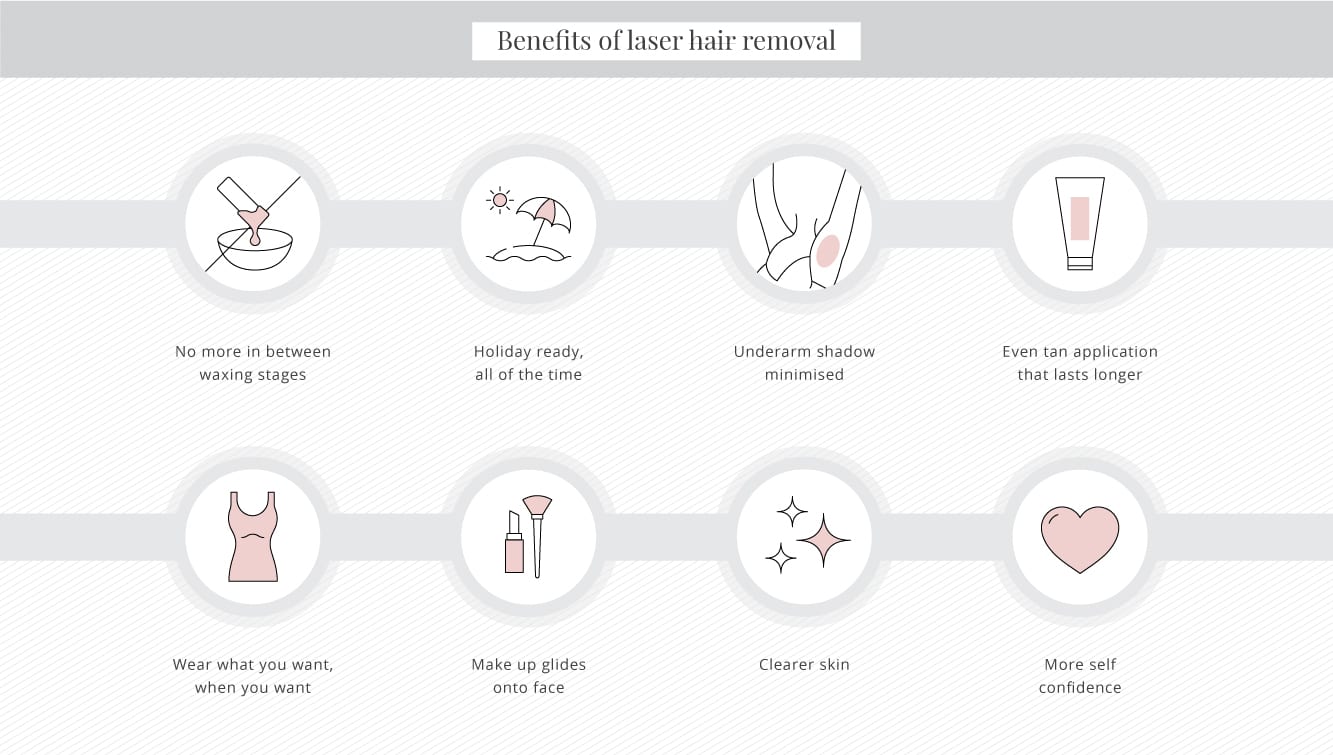
It’s important to note that laser hair removal is not a miracle overnight cure. It can be a long process but is so worthwhile. Results from laser can be seen after just a few sessions. Thick, coarse hairs reduce to become finer and lighter and are easier to maintain. After a few sessions you may only need to shave once in between your treatments.
Does the success rate of laser hair removal make it worth it?
Yes, the success rate of laser hair removal is definitely worth the time and investment needed to see results. If excess hair is a real issue, laser hair removal is the one of the only methods of hair removal that is going to give long lasting results. Waxing and epilating only gives a temporary result lasting only a number of weeks for some people. For 4-6 weeks before you wax or epilate you need to allow hair to grow, this in itself can be inconvenient. You do not need to do this with laser and can remove your hair by shaving anytime before a treatment. This means you can be hair free all of the time. After a few sessions of laser the need to shave will decrease.
Any side effects from shaving ie ingrown hairs or shaving rash will improve after each session. As hair thins and growth reduces so does the effect shaving will have on the skin. After a full course any regrowth will be minimal and top ups may only be needed a few times a year.
Laser hair removal has a very high success rate and is proven to work
Millions of people all around the world are benefiting from this amazing treatment. Be one of them and start today. Consultations with us are free and take approx 30 minutes. Our friendly team will talk you through the whole process so you know what to expect. We also insist on a patch test before you start to ensure the safety of your skin.

